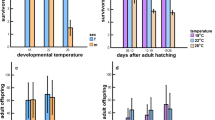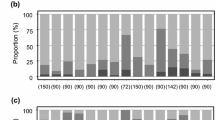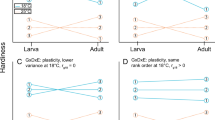Abstract
Understanding adaptations to climatic stresses has been a longstanding issue in evolutionary biology. Clinal patterns for stress tolerance traits at interspecific as well as intraspecific levels provide an opportunity to comprehend the adaptive divergence acquired in the closely related species among different geographical populations. In the present study, we investigated the geographical differences for basal as well as induced thermal tolerance (hardening) in two sympatric sibling Drosophila species (D. leontia and D. kikkawai) along a latitudinal transect (South: 8°06′N to North: 32°40′N) across India. A higher relative abundance of D. leontia was observed in the southern localities (tropical) while D. kikkawai was more abundant in the northern localities (sub-tropical). Both the species showed a negative cline for heat tolerance along the latitude i.e. following a trend of increased tolerance level in the southern populations compared to northern ones. Contrarily, a positive cline for cold tolerance was evident in D. kikkawai, while such intra-specific population differences were non-significant in D. leontia. Further, we found the evidence for heat and cold hardening effects only in D. kikkawai. In D. kikkawai, higher hardening capacity for heat as well as cold tolerance was observed in northern populations compared to southern populations, despite lower basal heat tolerance in northern populations. In conclusion, clinal patterns for hardening capacity for heat and cold tolerance in D. kikkawai while absence of the same in D. leontia suggest divergent evolutionary history of these two sympatric sibling species.








Similar content being viewed by others
References
Addo-Bediako A, Chown SL, Gaston KJ (2000) Thermal tolerance, climatic variability and latitude. Proc R Soc B 267:739–745
Angilletta MJ (2009) Thermal adaptation: a theoretical and empirical synthesis. Oxford University Press, Oxford
Angilletta MJ, Wilson RS, Navas CA, James RS (2003) Trade-offs and the evolution of thermal reaction norms. Trends Ecol Evol 18:234–240
Arthur AL, Weeks AR, Sgro CM (2008) Investigating latitudinal clines for life history and stress resistance traits in Drosophila simulans from eastern Australia. J Evol Biol 21:1470–1479
Berrigan D, Hoffmann AA (1998) Correlations between measures of heat resistance and acclimation in two species of Drosophila and their hybrids. Biol J Linn Soc 64:449–462
Chown SL, Terblanche JS (2007) Physiological diversity in insects: ecological and evolutionary contexts. Adv in Insect Phys 33:51–152
Climatological tables of observatories in India (2010) Indian Meteorological Department, pp 1–782
Cooper BS, Czarnoleski M, Angilletta MJ (2010) Acclimation of thermal physiology in natural populations of Drosophila melanogaster: a test of an optimality model. J Evol Biol 23:2346–2355
Cooper BS, Tharp JM, Jernberg J II, Angilletta MJ (2012) Developmental plasticity of thermal tolerances in temperate and subtropical populations of Drosophila melanogaster. J Therm Biol 37:211–216
Cossins AR, Bowler K (1987) Temperature biology of animals. Chapman and Hall, New York
Gibert P, Huey RB (2001) Chill-coma temperature in Drosophila: effects of developmental temperature, latitude, and phylogeny. Physiol Biochem Zool 74:429–434
Guerra D, Cavicchi S, Krebs RA, Loeschcke V (1997) Resistance to heat and cold stress in Drosophila melanogaster: intra and inter population variation in relation to climate. Genet Sel Evol 29:497–510
Hoffmann AA (1990) Acclimation for desiccation resistance in Drosophila melanogaster and the association between acclimation responses and genetic variation. J Insect Physiol 36:885–891
Hoffmann AA (2010) Physiological climatic limits in Drosophila: patterns and predictions. J Exp Biol 213:870–880
Hoffmann AA, Watson M (1993) Geographical variation in the acclimation responses of Drosophila to temperature extremes. Am Nat 142:93–113
Hoffmann AA, Weeks AR (2007) Climatic selection on genes and traits after a 100 year-old invasion: a critical look at the temperate-tropical clines in Drosophila melanogaster from eastern Australia. Genetica 129:133–147
Hoffmann AA, Anderson A, Hallas R (2002) Opposing clines for high and low temperature resistance in Drosophila melanogaster. Ecol Lett 5:614–618
Hoffmann AA, Sørensen JG, Loeschcke V (2003) Adaptation of Drosophila to temperature extremes: bringing together quantitative and molecular approaches. J Therm Biol 28:175–216
Hoffmann AA, Shirriffs J, Scott M (2005) Relative importance of plastic vs. genetic factors in adaptive differentiation: geographical variation for stress resistance in Drosophila melanogaster from eastern Australia. Funct Ecol 19:222–227
Karan D, Parkash R (1998) Desiccation and starvation resistance exhibit opposite latitudinal clines in Indian populations of Drosophila kikkawai. Ecol Entomol 23:391–396
Kellermann V, Heerwaarden VB, Sgrò CM, Hoffmann AA (2009) Fundamental evolutionary limits in ecological traits drive Drosophila species distributions. Science 325:1244–1246
Kellermann V, Overgaard J, Hoffmann AA, Flojgaard C, Svenning JC, Loeschcke V (2012) Upper thermal limits of Drosophila are linked to species distributions and strongly constrained phylogenetically. Proc Nat Acad Sci (USA) 109:16228–16233
Kellett M, Hoffman AA, McKechnie SW (2005) Hardening capacity in the Drosophila melanogaster species group is constrained by basal thermotolerance. Funct Ecol 19:853–858
Kimura MT (1988) Adaptations to temperate climates and evolution of overwintering strategies in the Drosophila melanogaster species group. Evolution 42:1288–1297
Lemeunier F, David JR, Tsacas L, Ashburner M (1986) The melanogaster species group. In: Ashburner M, Carson HL, Thompson JN (eds) The genetics and biology of Drosophila. Academic Press, New York, pp 147–256
Levins R (1969) Thermal acclimation and heat resistance in Drosophila species. Am Nat 103:483–499
Lindsey CF, Fanara JJ, Morgan TJ (2012) Genetic variation in heat-stress tolerance among South American Drosophila populations. Genetica 139:1331–1337
Loeschcke V, Krebs RA, Barker JSF (1994) Genetic variation for resistance and acclimation to high temperature stress in Drosophila buzzatii. Biol J Linn Soc 52:83–92
Markow TA, O’Grady P (2006) A guide to species identification and use. Elsevier, London
Mitchell KA, Sgro CM, Hoffmann AA (2011) Phenotypic plasticity in upper thermal limits is weakly related to Drosophila species distributions. Funct Ecol 25:661–670
Overgaard J, Kristensen TN, Mitchell KA, Hoffmann AA (2011) Thermal tolerance in widespread and tropical Drosophila Species: does phenotypic plasticity increase with latitude? Am Nat 178:S80–S96
Ragland GJ, Kingsolver JG (2008) Evolution of thermotolerance in seasonal environments: the effects of annual temperature variation and life-history timing in Wyeomyia smithii. Evolution 62:1345–1357
Rako L, Hoffmann AA (2006) Complexity of the cold acclimation response in Drosophila melanogaster. J Insect Physiol 52:94–104
Ramniwas S, Kajla B (2012) Divergent strategy for adaptation to drought stress in two sibling species of montium species subgroup: Drosophila kikkawai and Drosophila leontia. J Insect Physiol 58:1525–1533
Sarup P, Loeschcke V (2010) Developmental acclimation affects clinal variation in stress resistance traits in Drosophila buzzatii. J Evol Biol 23:957–965
Schilthuizen M, Kellermann V (2014) Contemporary climate change and terrestrial invertebrates: evolutionary versus plastic changes. Evol Appl 7:56–67
Sgro CM, Overgaard J, Kristensen KA, Cockerell FE, Hoffmann AA (2010) A comprehensive assessment of geographic variation in heat tolerance and hardening capacity in populations of Drosophila melanogaster from eastern Australia. J Evol Biol 23:2484–2493
Stratman R, Markow TA (1998) Resistance to thermal stress in Desert Drosophila. Funct Ecol 8:965–970
Tsacas L, David J (1977) Systematics and biogeography of the Drosophila kikkawai complex with descriptions of new species (Diptera, Drosophilidae). Ann Soc Entomol Fr (NS) 13:675–693
Author information
Authors and Affiliations
Corresponding author
Electronic supplementary material
Below is the link to the electronic supplementary material.
Rights and permissions
About this article
Cite this article
Ranga, P., Prakash, R. & Mrinal, N. Sibling Drosophila species (Drosophila leontia and Drosophila kikkawai) show divergence for thermotolerance along a latitudinal gradient. Evol Ecol 31, 93–117 (2017). https://doi.org/10.1007/s10682-016-9880-1
Received:
Accepted:
Published:
Issue Date:
DOI: https://doi.org/10.1007/s10682-016-9880-1




